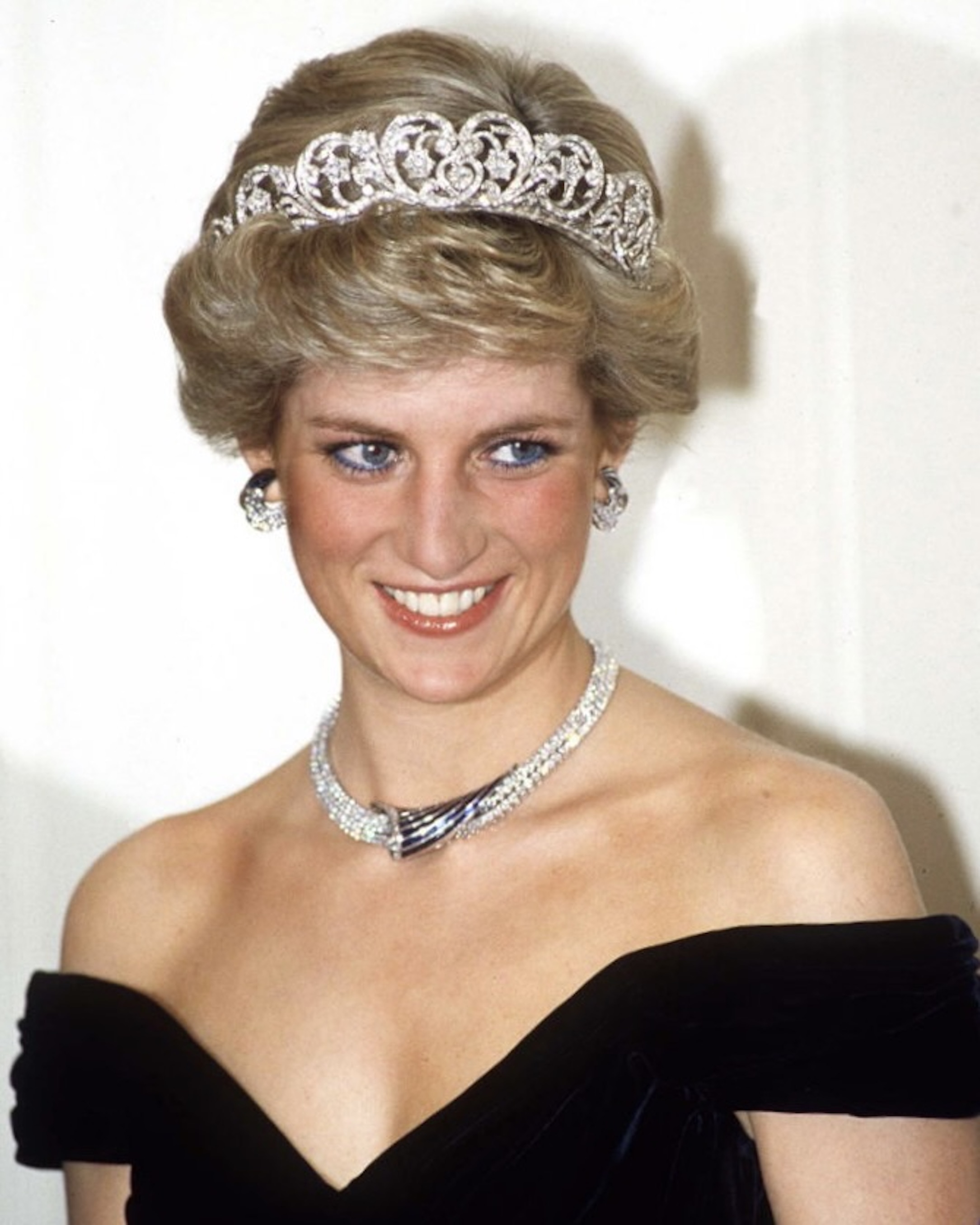In a revelation that has sent waves of nostalgia and pride through Britain, Charles Spencer, brother of the late Princess Diana, has reportedly confirmed that the legendary Spencer Tiara
— valued at an estimated £400,000 — will one day belong to Princess Charlotte, the only daughter of Prince William and Princess Catherine.
This glittering heirloom is far more than diamonds and gold. It is history — the very crown that once symbolized Diana’s independence and grace.
💎 The Tiara That Captured the World
When Lady Diana Spencer walked down the aisle of St. Paul’s Cathedral in July 1981, she stunned the world — not just with her fairytale gown, but with her choice to wear her
own family’s tiara, not a royal one.
The Spencer Tiara, adorned with tulip and star motifs crafted from intricate 18th-century diamonds, belonged to Diana’s father, John Spencer, 8th Earl Spencer
. Passed through generations of Spencer women, it became Diana’s personal favorite — a constant sparkle through her happiest and loneliest days.
After her tragic death in 1997, the tiara was locked away at
Althorp House, the Spencer family estate. For nearly three decades, it has remained unseen — except for a brief, poignant reappearance at Diana’s niece Celia McCorquodale’s wedding in 2018.
👑 A New Generation’s Turn
According to sources close to the Spencer family, Charles Spencer intends for the tiara to stay within Diana’s bloodline — and that means Princess Charlotte
, not Princess Lilibet, will one day wear it.
Jewelry expert Maxwell Stone explained:
“The Spencer Tiara isn’t part of the Crown Jewels or royal collection — it’s privately owned. As such, it remains within the Spencer family, and it’s likely that Princess Charlotte will inherit it in the future.”
He added that while both Charlotte and her cousin Princess Lilibet share Diana’s lineage, Charlotte’s position as a core royal — and her visible role in public life — make her the natural choice.
“Charlotte represents her grandmother’s legacy in a way that’s deeply symbolic,” Stone noted. “Seeing her wear the tiara at a future royal wedding would be a moment of poetic continuity.”
💌 Why Charlotte, Not Lilibet?
The decision has stirred debate among royal watchers. Lilibet, daughter of Prince Harry and Meghan Markle, also descends directly from Diana — but her upbringing across the Atlantic, away from royal protocol, may limit her connection to such traditional heirlooms.
“Lilibet is part of the Spencer bloodline,” Stone clarified, “but her life is rooted outside the monarchy. Charlotte, however, stands at the heart of it. The tiara’s meaning — service, elegance, resilience — aligns perfectly with the role she’s expected to play.”
🌷 A Legacy of Grace and Strength
For many, this news is more than royal gossip — it’s a continuation of Diana’s story. Those who remember her wedding day recall the tiara’s delicate shimmer beneath her veil — a sparkle that became a symbol of both hope and heartbreak.
The thought of Princess Charlotte one day wearing that same tiara — perhaps on her own wedding day — carries profound emotion for millions who grew up admiring Diana’s warmth and courage.
Fashion historians predict that the tiara’s reemergence will be one of the most significant royal fashion moments of the coming decades. “It won’t just be jewels,” one expert said. “It will be memory, continuity, and love reborn.”
💫 The Tiara’s Timeless Beauty
The Spencer Tiara is a masterpiece of English craftsmanship. Assembled from multiple antique pieces, it features a central heart-shaped motif surrounded by floral scrolls and starbursts — each diamond meticulously cut, each curve echoing a century of artistry.
Countess Cynthia Spencer first received it as a wedding gift in 1919. Diana later wore it dozens of times throughout the 1980s — at state dinners, charity galas, and royal tours. “It was her favorite,” friends recall. “She said it felt lighter than any crown.”
Its estimated worth of £400,000 doesn’t begin to capture its emotional value — a sparkle that carries laughter, sorrow, and the timeless image of a princess who changed the world by being real.
❤️ The People’s Tiara
When Princess Charlotte eventually inherits the Spencer Tiara, she won’t just be wearing jewels — she’ll be wearing her grandmother’s story.
A story of love, resilience, and defiance. A story that reminds the world that grace is not inherited — it’s chosen.
And when that tiara once again catches the light before a global audience, it will not just reflect diamonds — but the enduring brilliance of Princess Diana’s legacy, shining through the next generation.
✨ “The tiara will glitter again,” one royal insider said softly. “And when it does, Diana’s spirit will be there — smiling, proud, and eternal.”
👑 THE RISING PRINCE: How King Charles’s Bold Decision Revived the Heart of the Monarchy


In the quiet corridors of Buckingham Palace, where portraits of queens and kings seem to watch over every generation’s turning point, a new chapter has begun — not with fanfare, but with faith. King Charles III, in a decision as symbolic as it is strategic, has elevated
James, Earl of Wessex, to the full honor of His Royal Highness Prince James of Wessex.
At seventeen, the youngest grandson of the late Queen Elizabeth II steps out of the shadows of royal anonymity into the gentle spotlight of destiny. His new title does more than crown a teenager — it rekindles the monarchy’s faith in its own future.
🌿 A PRINCE FOR A NEW AGE
Born into a family defined by duty yet scarred by scandal, James’s ascent arrives as a whisper of renewal. For years, the son of
Prince Edward and Sophie, Duchess of Edinburgh, lived a life deliberately free from royal rigidity. No paparazzi trails. No gilded tantrums. Just school, sport, and small-town normalcy.
That was by design. His parents, inspired by humility rather than hierarchy, raised him to value
effort over entitlement. Sophie once said, “We want them to grow up understanding work’s value — not shrouded in titles.”
Now, King Charles’s gesture — quiet, lawful, steeped in century-old royal prerogative — changes that trajectory. But it does so with care. It’s not a spotlight thrust, it’s an invitation extended — a call to service for a generation that must make monarchy matter again.
👑 CHARLES’S STRATEGY OF GRACE
Palace insiders describe this as Charles’s most thoughtful move since his coronation. With age and illness tempering his reign, and the roster of working royals shrinking, he recognizes the need for youthful strength — figures who embody service, not spectacle.
The King’s choice of James is telling. Here is a young man untarnished by controversy, molded by Edward’s steadiness and Anne’s discipline. His inclusion reflects the late Queen’s long view: that endurance rests not on grandeur, but on good character.
Princess Anne herself, ever pragmatic, called it “an act of balance.”
“The Crown’s strength,” she said at Windsor, “lies not in perfection, but participation. James’s title ensures that weight is shared — not shouldered by too few.”
In that sentence lies the essence of Charles’s reign: restraint, continuity, and a crown that learns to breathe.
💫 THE MAKING OF A MODERN PRINCE
Until now, James was the monarchy’s quiet constant. No scandals, no social media noise — just a lanky, thoughtful young man who adored sailing on the Solent, volunteered for environmental causes, and shared his grandfather Philip’s fascination with the outdoors.
His education at Radley College shaped an independent spirit. His parents’ insistence on normalcy gave him empathy rare among royals his age. It is precisely that ordinariness — that lack of entitlement — that makes him invaluable to the modern royal project.
With his new title, he will likely join engagements alongside the Prince and Princess of Wales, supporting youth, conservation, and education initiatives. To some, that sounds like logistics. To the monarchy, it’s lifeblood — fresh energy for a family walking the narrow bridge between relevance and reverence.
🕊️ THE ANCHORS: ANNE AND EDWARD
Behind this transformation stand two unsung architects: Princess Anne and Prince Edward. Their voices, often drowned out by louder royal headlines, now shape the dynasty’s evolution.
Anne, the iron spine of Windsor duty, sees this as “preparation, not promotion.” Edward, ever loyal to both his brother and his father’s ideals, called it “a way to serve William’s vision, not compete with it.”
Together, they offer what the monarchy has always needed — not rebellion, but rhythm. A family that learns from the past instead of repeating it.
💔 WHY NOW
This moment isn’t about privilege — it’s about preservation.
King Charles, battling both time and illness, knows his reign will be defined by transition. The monarchy’s future rests on a generation who can connect, not command. William and Catherine have become the beating heart of that vision — but even hearts need support.
James’s elevation builds that bridge. He’s young enough to represent tomorrow, yet grounded enough to honor yesterday. A prince not of pomp, but of purpose.
🌅 A KINGDOM REIMAGINED
The ripple extends beyond James himself. His new role quietly reinforces William and Catherine’s coming era, offering them a trusted ally for the decades ahead. It also signals a clear message to the public: the monarchy is not shrinking — it’s evolving.
In a world that questions royal relevance, this move answers not with noise, but with nurture.
✨ THE LEGACY CONTINUES
As the palace lights glow over autumn gardens, one can almost imagine King Charles looking out from his study window — proud, reflective, and perhaps relieved. His youngest nephew, now a prince, carries not just a title, but a torch.
For James, the path ahead won’t be about crowns or carriages. It will be about connection. About showing that even the oldest institutions can find renewal in youth, humility, and hope.
And for Britain — weary yet watchful — it’s a reminder that sometimes, the smallest steps within the palace walls can echo the loudest beyond them.







